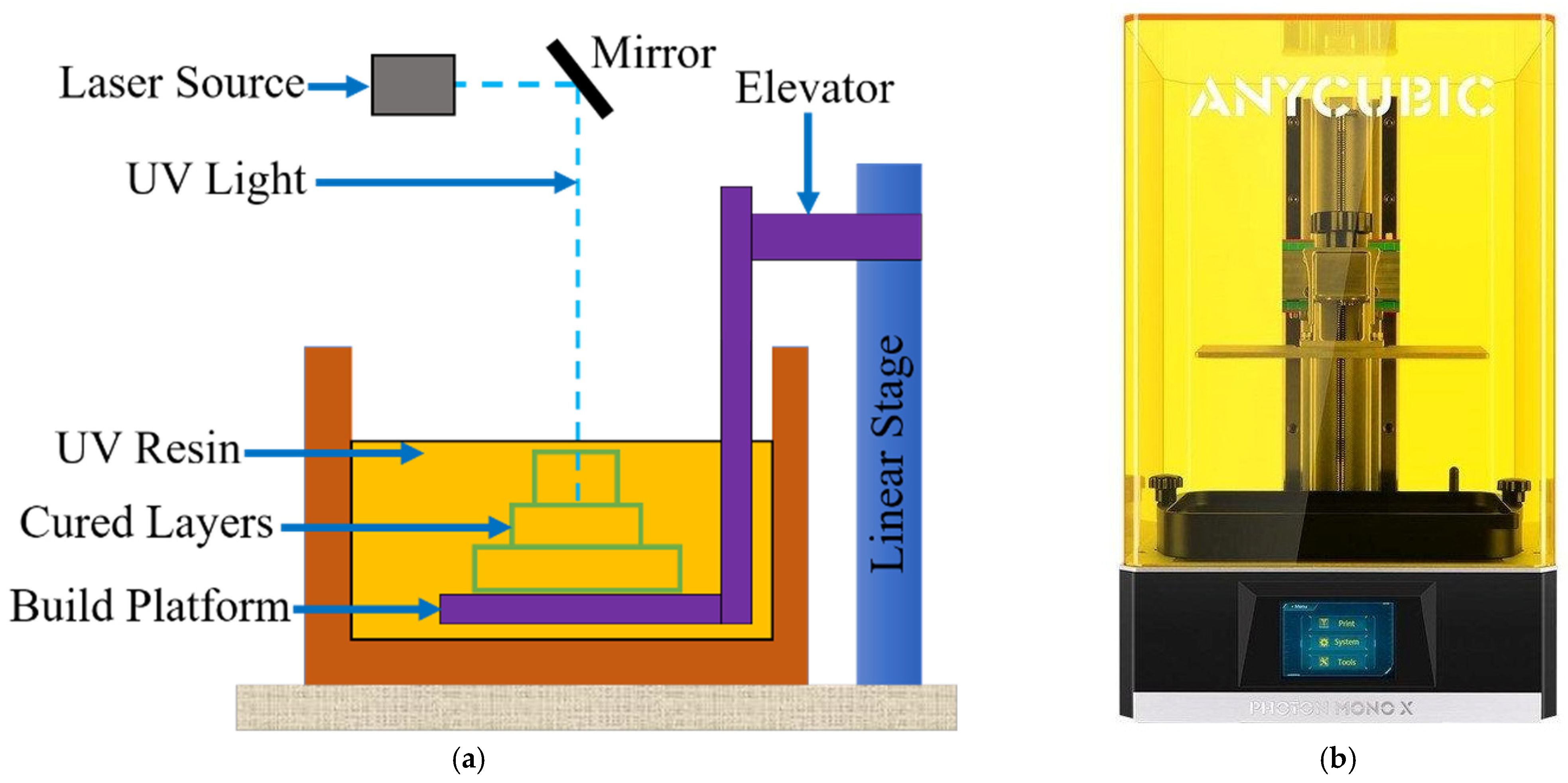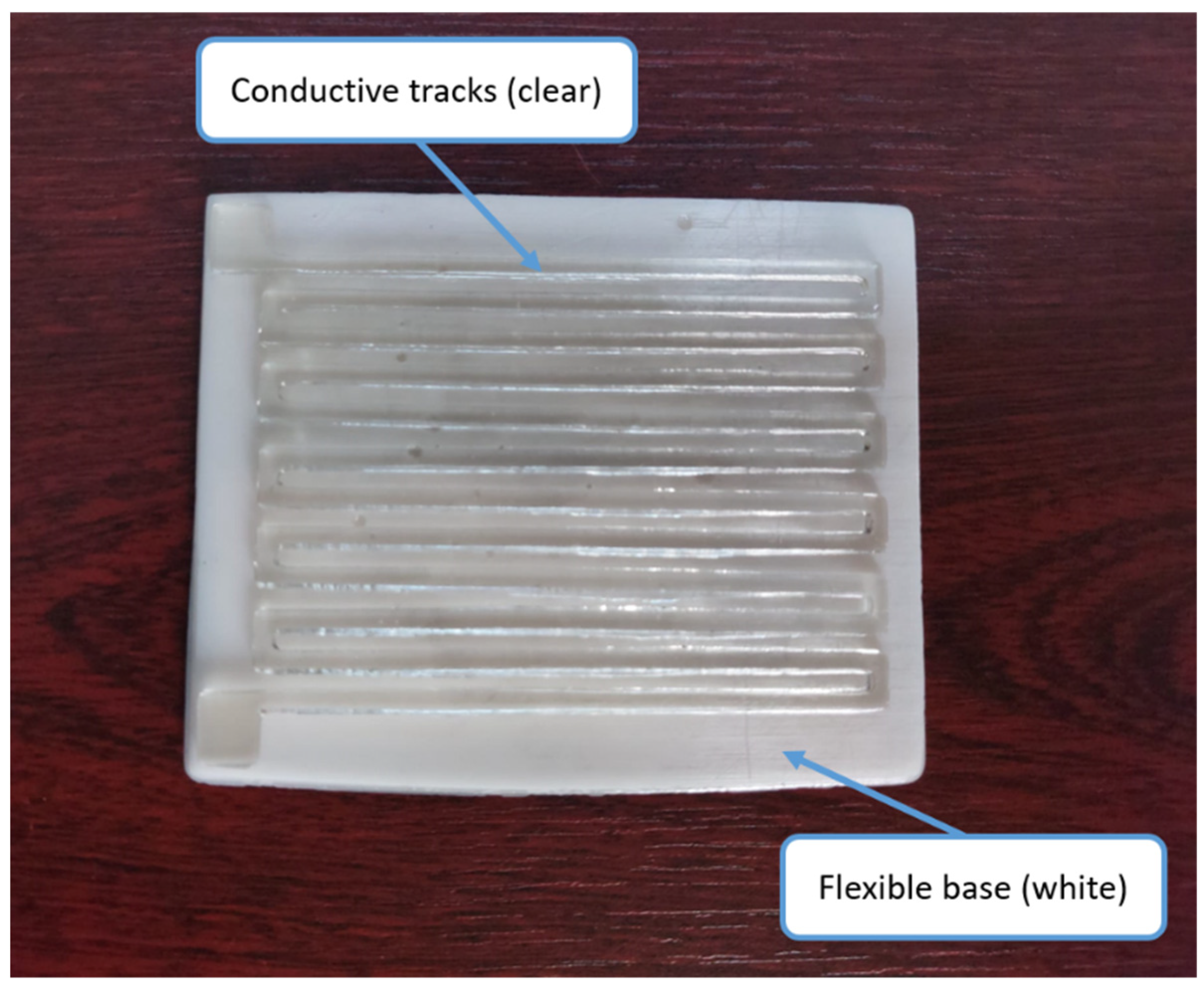Additive Manufactured Strain Sensor Using Stereolithography Method with Photopolymer Material
Abstract
1. Introduction
2. Materials and Methods
2.1. Materials
2.2. Design of Strain Sensor
2.3. Stereolithography Method
2.4. Experimental Setup
3. Experimental Results
3.1. 3D Printing Process and Testing
3.2. Results
3.3. Discussion
4. Conclusions
Author Contributions
Funding
Institutional Review Board Statement
Data Availability Statement
Acknowledgments
Conflicts of Interest
References
- Aimar, A.; Palermo, A.; Innocenti, B. The Role of 3D Printing in Medical Applications: A State of the Art. J. Healthc. Eng. 2019, 2019, 1–10. [Google Scholar] [CrossRef] [PubMed]
- Ricles, L.M.; Coburn, J.C.; Di Prima, M.; Oh, S.S. Regulating 3D-Printed Medical Products. Sci. Transl. Med. 2018, 10, eaan6521. [Google Scholar] [CrossRef]
- Harussani, M.M.; Sapuan, S.M.; Nadeem, G.; Rafin, T.; Kirubaanand, W. Recent Applications of Carbon-Based Composites in Defence Industry: A review. Def. Technol. 2022, 18, 1281–1300. [Google Scholar] [CrossRef]
- Zampetakis, I.; Hetherington, A.; Perriman, A.; Scarpa, F. Cactus-Based Solids and Bio-Composites for Energy Dissipation in Defence and Biomedical Applications. In Proceedings of the 18th European Conference on Composite Materials, ECCM 2018, Athens, Greece, 24–28 June 2018. [Google Scholar]
- Yap, Y.L.; Sing, S.L.; Yeong, W.Y. A Review of 3D Printing Processes and Materials for Soft Robotics. Rapid Prototyp. J. 2020, 26, 1345–1361. [Google Scholar] [CrossRef]
- Oruganti, S.K.; Khosla, A. 3D Printing and Wireless Power Transfer Systems for Soft Robotics Applications. ECS Trans. 2020, 98, 45–55. [Google Scholar] [CrossRef]
- Hamidi, A.; Yonas, T. 3D Printing of very Soft Elastomer and Sacrificial Carbohydrate Glass/Elastomer Structures for Robotic Applications. Mater. Des. 2020, 187, 108324. [Google Scholar] [CrossRef]
- Lowke, D.; Dini, E.; Perrot, A.; Weger, D.; Gehlen, C.; Dillenburger, B. Particle-Bed 3D Printing in Concrete Construction–Possibilities and Challenges. Cem. Concr. Res. 2018, 112, 50–65. [Google Scholar] [CrossRef]
- Burger, J.; Lloret-Fritschi, E.; Scotto, F.; Demoulin, T.; Gebhard, L.; Mata-Falcón, J.; Flatt, R.J. Eggshell: Ultra-Thin Three-Dimensional Printed Formwork for Concrete Structures. 3d Print. Addit. Manuf. 2020, 7, 48–59. [Google Scholar] [CrossRef]
- Berman, B. 3-D Printing: The New Industrial Revolution. Bus. Horiz. 2012, 55, 155–162. [Google Scholar] [CrossRef]
- Takahashi, H.; Jeeeun, K. 3D Printed Fabric: Techniques for Design and 3D Weaving Programmable Textiles. In Proceedings of the 32nd Annual ACM Symposium on User Interface Software and Technology, New Orleans LA, USA, 1–5 October 2019; pp. 43–51. [Google Scholar]
- Nolden, R.; Kerstin, Z.; Anne, S.P. Development of Flexible and Functional Sequins Using Subtractive Technology and 3d printing for Embroidered Wearable Textile Applications. Materials 2021, 14, 2633. [Google Scholar] [CrossRef]
- Tarfaoui, M.; Nachtane, M.; Goda, I.; Qureshi, Y.; Benyahia, H. 3D Printing to Support the Shortage in Personal Protective Equipment Caused by COVID-19 Pandemic. Materials 2020, 13, 3339. [Google Scholar] [CrossRef] [PubMed]
- Domínguez-Robles, J.; Martin, N.K.; Fong, M.L.; Stewart, S.A.; Irwin, N.J.; Rial-Hermida, M.I.; Larrañeta, E. Antioxidant PLA Composites Containing Lignin for 3D Printing Applications: A Potential Material for Healthcare Applications. Pharmaceutics 2019, 11, 165. [Google Scholar] [CrossRef] [PubMed]
- Pecho, P.; Ažaltovič, V.; Kandera, B.; Bugaj, M. Introduction Study of Design and Layout of UAVs 3D Printed Eings in Relation to Optimal Lightweight and Load Distribution. Transp. Res. Procedia 2019, 40, 861–868. [Google Scholar] [CrossRef]
- Gouzman, I.; Grossman, E.; Verker, R.; Atar, N.; Bolker, A.; Eliaz, N. Advances in Polyimide-Based Materials for Space Applications. Adv. Mater. 2019, 31, 1807738. [Google Scholar] [CrossRef]
- Oyinloye, T.M.; Yoon, W.B. Application of Computational Fluid Dynamics (CFD) Simulation for the Effective Design of Food 3D Printing (A Review). Processes 2021, 9, 1867. [Google Scholar] [CrossRef]
- Nachal, N.; Moses, J.A.; Karthik, P.; Anandharamakrishnan, C. Applications of 3D Printing in Food Processing. Food Eng. Rev. 2019, 11, 123–141. [Google Scholar] [CrossRef]
- Shahrubudin, N.; Lee, T.C.; Ramlan, R.J.P.M. An Overview on 3D Printing Technology: Technological, Materials, and Applications. Procedia Manuf. 2019, 35, 1286–1296. [Google Scholar] [CrossRef]
- Ertugrul, I. The Fabrication of Micro Beam from Photopolymer by Digital Light Processing 3D Printing Technology. Micromachines 2020, 11, 518. [Google Scholar] [CrossRef]
- Pagliano, S.; Marschner, D.E.; Maillard, D.; Ehrmann, N.; Stemme, G.; Braun, S.; Niklaus, F. Micro 3D Printing of a Functional MEMS Accelerometer. Microsyst. Nanoeng. 2022, 8, 105. [Google Scholar] [CrossRef]
- Stassi, S.; Cooperstein, I.; Tortello, M.; Pirri, C.F.; Magdassi, S.; Ricciardi, C. Reaching Silicon-Based NEMS Performances with 3D Printed Nanomechanical Resonators. Nat. Commun. 2021, 12, 6080. [Google Scholar] [CrossRef]
- Özsoy, K.; Bekir, A. Real-Time Data Analysis with Artificial Intelligence in Parts Manufactured by FDM Printer Using Image Processing Method. J. Test. Eval. 2021, 50, 1–17. [Google Scholar] [CrossRef]
- Ismail, K.I.; Yap, T.C.; Ahmed, R. 3D-Printed Fiber-Reinforced Polymer Composites by Fused Deposition Modelling (FDM): Fiber Length and Fiber Implementation Techniques. Polymers 2022, 14, 4659. [Google Scholar] [CrossRef] [PubMed]
- Ulkir, O.; Ertugrul, I.; Akkus, N.; Ozer, S. Fabrication and Experimental Study of Micro-gripper with Electrothermal Actuation by Stereolithography Method. J. Mater. Eng. Perform. 2022, 31, 8148–8159. [Google Scholar] [CrossRef]
- Xu, X.; Robles-Martinez, P.; Madla, C.M.; Joubert, F.; Goyanes, A.; Basit, A.W.; Gaisford, S. Stereolithography (SLA) 3D printing of an Antihypertensive Polyprintlet: Case Study of an Unexpected Photopolymer-Drug Reaction. Addit. Manuf. 2020, 33, 101071. [Google Scholar] [CrossRef]
- Wu, C.; Do, T.T.; Tran, P. Mechanical Properties of Polyjet 3D-Printed Composites Inspired by Space-Filling Peano Curves. Polymers 2021, 13, 3516. [Google Scholar] [CrossRef]
- Gan, X.; Wang, J.; Wang, Z.; Zheng, Z.; Lavorgna, M.; Ronca, A.; Xia, H. Simultaneous Realization of Conductive Segregation Network Microstructure and Minimal Surface Porous Macrostructure by SLS 3D Printing. Mater. Des. 2019, 178, 107874. [Google Scholar] [CrossRef]
- Wang, J.; Liu, Y.; Fan, Z.; Wang, W.; Wang, B.; Guo, Z. Ink-Based 3D Printing Technologies for Graphene-Based Materials: A Review. Adv. Compos. Hybrid Mater. 2019, 2, 1–33. [Google Scholar] [CrossRef]
- Wu, D.; Zhao, Z.; Zhang, Q.; Qi, H.J.; Fang, D. Mechanics of Shape Distortion of DLP 3D Printed Structures During UV Post-Curing. Soft Matter 2019, 15, 6151–6159. [Google Scholar] [CrossRef]
- Do, A.V.; Worthington, K.S.; Tucker, B.A.; Salem, A.K. Controlled Drug Delivery from 3D Printed Two-Photon Polymerized Poly (Ethylene Glycol) Dimethacrylate Devices. Int. J. Pharm. 2018, 552, 217–224. [Google Scholar] [CrossRef]
- Geng, Q.; Wang, D.; Chen, P.; Chen, S.C. Ultrafast Multi-Focus 3-D Nano-Fabrication Based on Two-Photon Polymerization. Nat. Commun. 2019, 10, 2179. [Google Scholar] [CrossRef]
- Bourdon, L.; Maurin, J.C.; Gritsch, K.; Brioude, A.; Salles, V. Improvements in Resolution of Additive Manufacturing: Advances in Two-Photon Polymerization and Direct-Writing Electrospinning Techniques. ACS Biomater. Sci. Eng. 2018, 4, 3927–3938. [Google Scholar] [CrossRef] [PubMed]
- Zhou, T.; Zhang, L.; Yao, Q.; Ma, Y.; Hou, C.; Sun, B.; Chen, H. SLA 3D Printing of High Quality Spine Shaped β-TCP Bioceramics for the Hard Tissue Repair Applications. Ceram. Int. 2020, 46, 7609–7614. [Google Scholar] [CrossRef]
- Mukhtarkhanov, M.; Perveen, A.; Talamona, D. Application of Stereolithography Based 3D Printing Technology in Investment Casting. Micromachines 2020, 11, 946. [Google Scholar] [CrossRef] [PubMed]
- Xiao, R.; Ding, M.; Wang, Y.; Gao, L.; Fan, R.; Lu, Y. Stereolithography (SLA) 3D Printing of Carbon Fiber-Graphene Oxide (CF-GO) Reinforced Polymer Lattices. Nanotechnology 2021, 32, 235702. [Google Scholar] [CrossRef] [PubMed]
- Liu, H.; Zhang, H.; Han, W.; Lin, H.; Li, R.; Zhu, J.; Huang, W. 3D Printed Flexible Strain Sensors: From Printing to Devices and Signals. Adv. Mater. 2021, 33, 2004782. [Google Scholar] [CrossRef] [PubMed]
- Munasinghe, N.; Woods, M.; Miles, L.; Paul, G. 3-D Printed Strain Sensor for Structural Health Monitoring. In Proceedings of the IEEE International Conference on Cybernetics and Intelligent Systems (CIS) and IEEE Conference on Robotics, Automation and Mechatronics (RAM), Bangkok, Thailand, 18–20 November 2019; pp. 275–280. [Google Scholar]
- Maurizi, M.; Slavič, J.; Cianetti, F.; Jerman, M.; Valentinčič, J.; Lebar, A.; Boltežar, M. Dynamic Measurements Using FDM 3D-Printed Embedded Strain Sensors. Sensors 2019, 19, 2661. [Google Scholar] [CrossRef]
- Cheng, H.W.; Yan, S.; Shang, G.; Wang, S.; Zhong, C.J. Strain Sensors Fabricated by Surface Assembly of Nanoparticles. Biosens. Bioelectron. 2021, 186, 113268. [Google Scholar] [CrossRef] [PubMed]
- Huang, C.B.; Yao, Y.; Montes-García, V.; Stoeckel, M.A.; Von Holst, M.; Ciesielski, A.; Samori, P. Highly Sensitive Strain Sensors Based on Molecules–Gold Nanoparticles Networks for High-Resolution Human Pulse Analysis. Small 2021, 17, 2007593. [Google Scholar] [CrossRef]
- Maturi, M.; Buratti, V.V.; Casula, G.; Locatelli, E.; Sambri, L.; Bonfiglio, A.; Comes Franchini, M. Surface-Stabilization of Ultrathin Gold Nanowires for Capacitive Sensors in Flexible Electronics. ACS Appl. Nano Mater. 2021, 4, 8668–8673. [Google Scholar] [CrossRef]
- Zhang, W.; Liu, Q.; Chen, P. Flexible Strain Sensor Based on Carbon Black/Silver Nanoparticles Composite for Human Motion Detection. Materials 2018, 11, 1836. [Google Scholar] [CrossRef]
- Sviridov, A.; Lopatina, I.; Kurganova, I. 3D-Printed Polyether Ether Ketone Samples Mechanical Properties Estimation. In IOP Conference Series: Materials Science and Engineering; IOP Publishing: Bristol, UK, 2019. [Google Scholar]







| Elemental Analysis of Resin | ||||
|---|---|---|---|---|
| Carbon (at.%) | Hydrogen (at.%) | Nitrogen (at.%) | Oxygen (at.%) | Sulfur (at.%) |
| 20.52 | 10.24 | 3.25 | 15.24 | 5.18 |
| Physical and Mechanical Features | ||||
| Density (liquid) g/ | Density (solid) g/ | Young’s Modulus (MPa) | Hardness (MPa) | Tensile Strength |
| 1.65 | 1.65 | 375 | 120 | 12 |
| Thermal and Electric Features | ||||
| Thermal Conductivity | Thermal Expansion | Temperature Coefficient | Electrical Resistivity | Relative Permittivity |
| 45 | 6.2 × 10−4 | 1.75 × 10−5 | 8.5 × 10−2 | 2.5 |
| Material | UV Resin | Fill Pattern | Hexagon |
|---|---|---|---|
| Infill Volume (%) | 80 | Lift Speed (mm/s) | 1.5 mm/s |
| Layer Thickness (mm) | 0.04 | Off-Time (s) | 0.50 |
| Normal Exposure Time (s) | 15 | Transition Layers | 15 |
| Bottom Exposure Time (s) | 120 | Bottom Layers | 25 |
Disclaimer/Publisher’s Note: The statements, opinions and data contained in all publications are solely those of the individual author(s) and contributor(s) and not of MDPI and/or the editor(s). MDPI and/or the editor(s) disclaim responsibility for any injury to people or property resulting from any ideas, methods, instructions or products referred to in the content. |
© 2023 by the authors. Licensee MDPI, Basel, Switzerland. This article is an open access article distributed under the terms and conditions of the Creative Commons Attribution (CC BY) license (https://creativecommons.org/licenses/by/4.0/).
Share and Cite
Ertugrul, I.; Ulkir, O.; Ersoy, S.; Ragulskis, M. Additive Manufactured Strain Sensor Using Stereolithography Method with Photopolymer Material. Polymers 2023, 15, 991. https://doi.org/10.3390/polym15040991
Ertugrul I, Ulkir O, Ersoy S, Ragulskis M. Additive Manufactured Strain Sensor Using Stereolithography Method with Photopolymer Material. Polymers. 2023; 15(4):991. https://doi.org/10.3390/polym15040991
Chicago/Turabian StyleErtugrul, Ishak, Osman Ulkir, Sezgin Ersoy, and Minvydas Ragulskis. 2023. "Additive Manufactured Strain Sensor Using Stereolithography Method with Photopolymer Material" Polymers 15, no. 4: 991. https://doi.org/10.3390/polym15040991
APA StyleErtugrul, I., Ulkir, O., Ersoy, S., & Ragulskis, M. (2023). Additive Manufactured Strain Sensor Using Stereolithography Method with Photopolymer Material. Polymers, 15(4), 991. https://doi.org/10.3390/polym15040991









